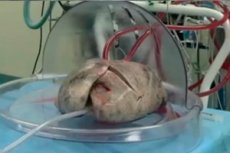New publications
Scientists have been able to grow an artificial lung
Last reviewed: 01.07.2025

All iLive content is medically reviewed or fact checked to ensure as much factual accuracy as possible.
We have strict sourcing guidelines and only link to reputable media sites, academic research institutions and, whenever possible, medically peer reviewed studies. Note that the numbers in parentheses ([1], [2], etc.) are clickable links to these studies.
If you feel that any of our content is inaccurate, out-of-date, or otherwise questionable, please select it and press Ctrl + Enter.

A research team at a Texas university has managed to grow a human lung in a laboratory setting. According to local media, the researchers used the lungs of two children who died in an accident and were unsuitable for transplantation. The scientists thoroughly cleaned the lungs of one of the children of lung cells, leaving only a kind of organ framework consisting of collagen and elastin. The scientists then transplanted cellular material from the lung of another child onto this framework, after which the sample was placed in a chamber containing a solution with a nutrient medium. After 30 days, the scientists discovered that the cells in the organ began to multiply and the organ reached a completely natural size.
To verify the reliability of the data obtained, the scientists conducted a repeat experiment. As one of the authors of the research project, Joan Nichols, notes, the experiments took a whole year to make sure that everything was done correctly. What could previously be considered science fiction is now a proven fact. According to Nichols, it will be possible to use lungs grown in such conditions for transplantation to patients in twelve years. She is confident that her students will be able to successfully continue her endeavors, and in the future, they will be the ones transplanting artificial lungs to patients.
The artificially grown lungs are practically indistinguishable from natural ones, except for a softer texture and a bright pink color. The scientists intend to continue their experiments and in the coming years they plan to conduct a series of experiments on pigs and transplant artificial organs into them. The research group notes that this method of creating organs was developed several years ago and initially experiments were conducted on rats. In the United States, as in other countries, there is an acute shortage of donor organs, in particular lungs. Over the course of a year, only half of the patients awaiting a transplant undergo lung transplant surgery (without a lung transplant, such patients live no longer than two years).
A little earlier, American researchers managed to create a new lung from embryonic and induced stem cells. This experiment, according to experts, will allow in the future to grow a lung that will be quite suitable for testing drugs or conducting scientific experiments. In addition, such lungs are quite suitable for transplantation to patients who need a new organ.
Another research group from Columbia University has managed to create intestines from stem cells. Now scientists are confident that at least six types of lung cells, as well as airways, can be obtained from stem cells, in particular, it is possible to create tissues that will help restore the lungs after severe injuries or damage. In addition, scientists believe that they will be able to create lungs using the new technology using the patient's own tissues who need a transplant.

 [
[